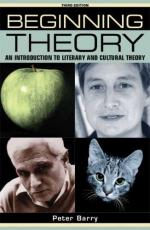
|
| Name: _________________________ | Period: ___________________ |
This quiz consists of 5 multiple choice and 5 short answer questions through Post-structuralism and deconstruction.
Multiple Choice Questions
1. Who presented I.A. Richard with the manuscript of the book which was published in 1930 with the title Seven Types of Ambiguity?
(a) Kurt Vonnegut.
(b) George Zebrowski.
(c) Wilfred Owen.
(d) William Empson.
2. The narrator explains that post-structuralism emerged in France in the late ________.
(a) 1970s.
(b) 1990s.
(c) 1930s.
(d) 1960s.
3. According to the chapter titled Theory Before Theory--Liberal Humanism, structuralism and post-structuralism originated in what country?
(a) France.
(b) Russia.
(c) Britain.
(d) United States.
4. The narrator explains in the Introduction that the emphasis on practice means that this is what form of book?
(a) Work book.
(b) E-book.
(c) Missal.
(d) Manuscript.
5. What does Peter Barry say was the earliest work of theory written by Aristotle?
(a) Politics.
(b) Generation of Animals.
(c) Poetics.
(d) Metaphysics.
Short Answer Questions
1. Who does the narrator say was the founder of a method of studying English which is still the norm today?
2. What does the narrator say the reader will have the most difficulty as the result of what?
3. Who was appointed Professor at King's College, London in 1840?
4. The narrator suggests that liberal humanists believe in ________ as something fixed and constant which great literature expresses.
5. I.A. Richards pioneered the technique called ________ which was also the title of his book in 1929.
|
This section contains 247 words (approx. 1 page at 300 words per page) |

|




